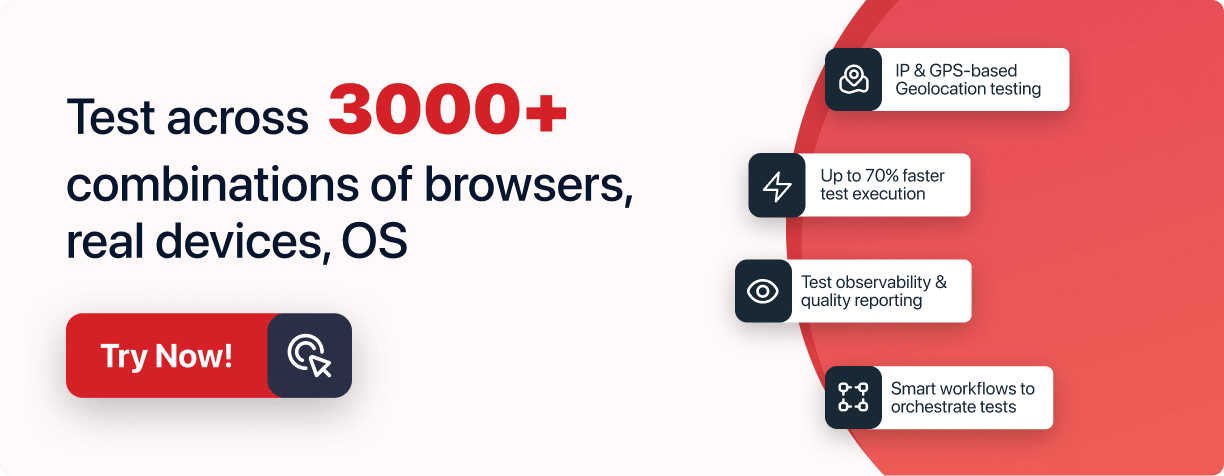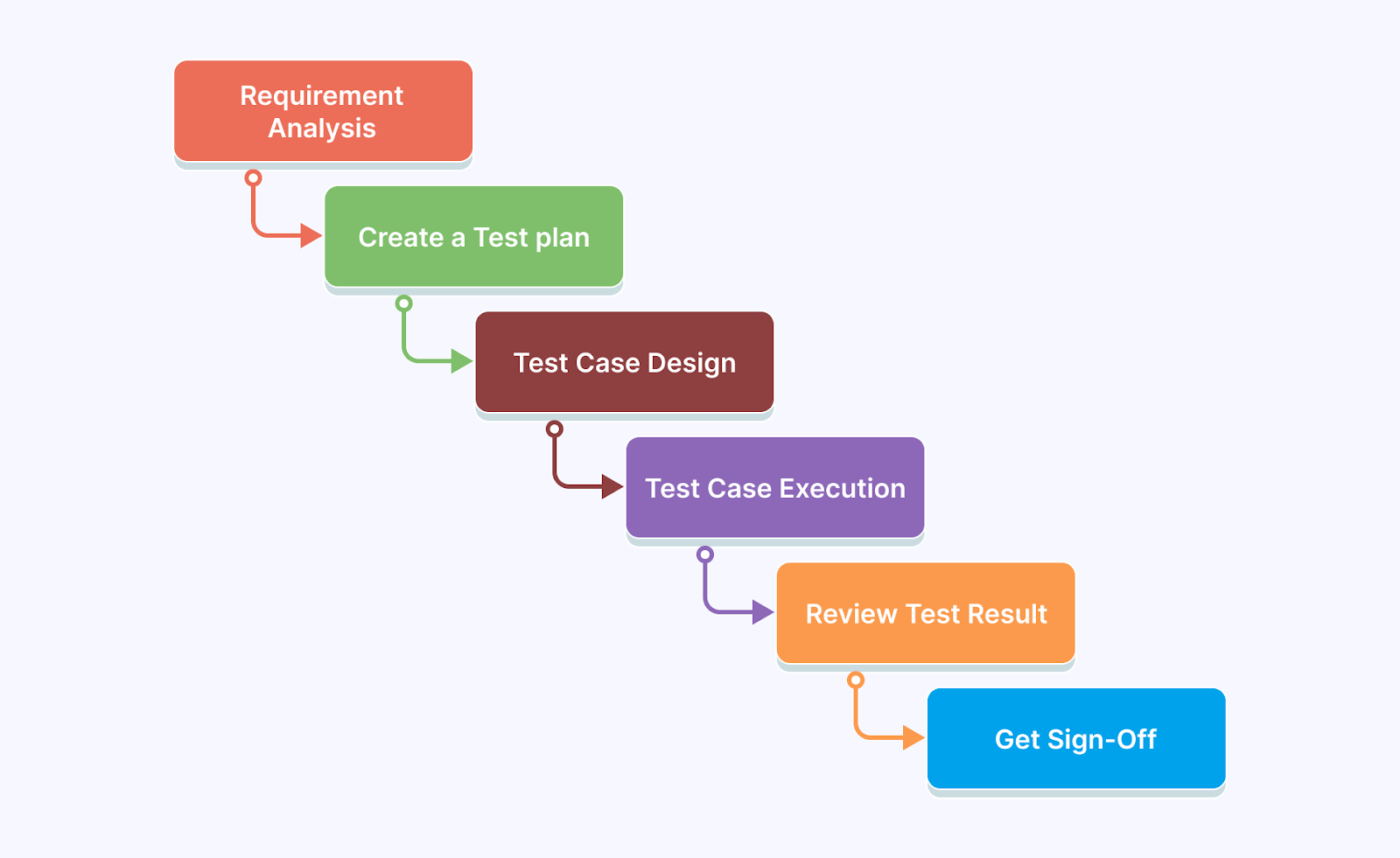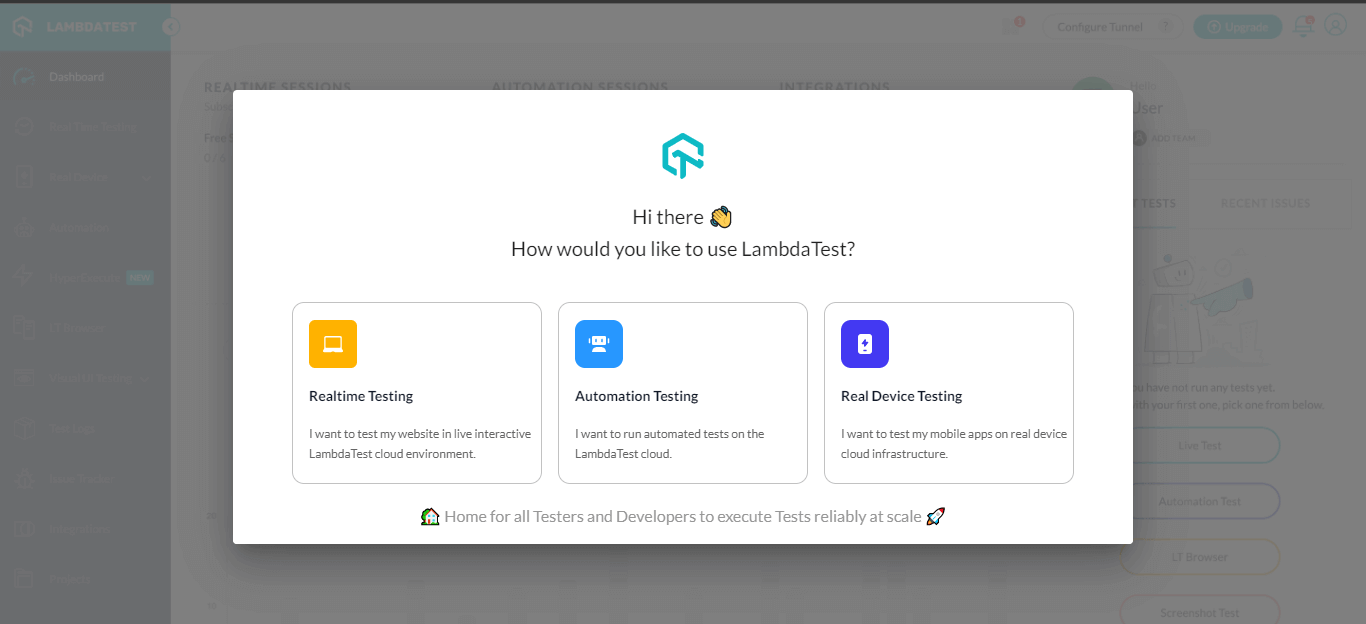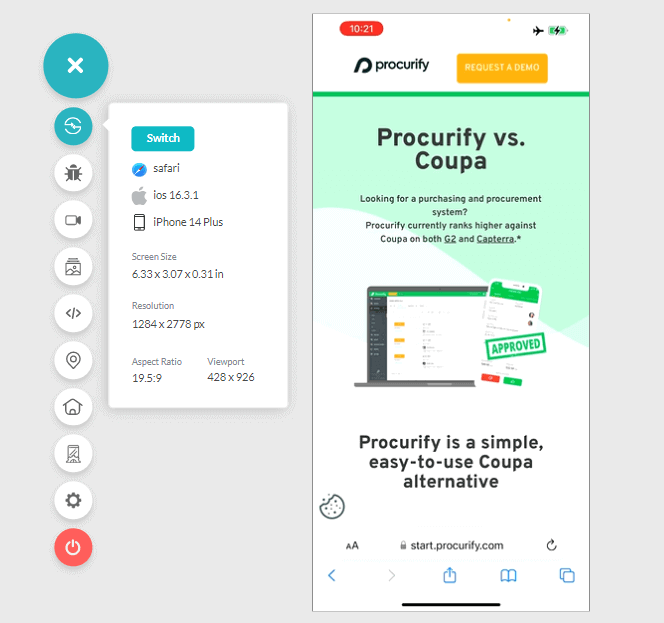
Learn the importance of acceptance testing and how it helps ensure your software application meets the desired specifications.
Acceptance testing involves validating an acceptance of the software application from the user's perspective. The software application is evaluated for compliance with business requirements to determine whether it is acceptable for release.
Performing tests in the Software Development Life Cycle (SDLC) is crucial to verify the software application for any bugs and quality. Throughout the SDLC process, multiple tests are performed to ensure the application meets the Software Requirement Specifications (SRS) before its release. Among those tests, acceptance testing is performed at the end of the Software Development Life Cycle after system testing. With this, you can verify whether the developed software application is ready for acceptance by the end user.
Acceptance testing focuses on verifying the application’s functionality from the end-user perspective without knowing the application's internal structure or implementation details. Due to this, acceptance testing is regarded as a type of black box testing. This approach helps ensure that the application meets user requirements and expectations.
Acceptance testing is a formal process that assesses whether a system meets user needs, requirements, and business processes, enabling users and customers to determine system acceptance.
Acceptance testing, or pre-production testing, checks whether the software application satisfies the acceptance criteria. It enables the end user and customer to decide whether or not it should be accepted by conducting formal testing of user needs, requirements, and business processes
The end-users and the QA team run acceptance tests at the last phase of the Software Testing Life Cycle (STLC). However, business analysts, support teams, users of applications, and others can also be involved in acceptance testing to provide feedback. They perform acceptance tests on two different conditions. First, after completion of system testing, and second, before the application is made available for actual use.
The primary purpose of the acceptance tests is to determine whether the developed software application is appropriate for its release. To accomplish this, the testing team releases the software application to the users after performing system testing. The user checks the application's function for acceptance in the controlled environment that simulates real-world usage scenarios. The software application is released on the market after fulfilling the acceptance criteria.
Acceptance tests intend to engage end-users of the developed software applications in the testing process to seek feedback and improvise them. However, the purpose of the acceptance tests is not limited to this. Below are some crucial purposes of acceptance tests that signify their importance.
In the Software Testing Life Cycle, at first, unit testing is performed, followed by integration testing and system testing. On their completion, we finally perform acceptance testing.
You may have a common question: when a software application undergoes several tests (unit, integration, and then system testing) before its final release, why do we need an acceptance test? This is because, at a later stage of the development process of an application, the end user should check for its functionality and work to ensure it meets their expectation.
Here are a few other reasons why the end-user and testers should conduct acceptance tests:
Now that you know the importance of acceptance testing, let us understand its practical application by stating examples. It will give you a clear idea of what and how exactly the acceptance test works.
Suppose a software application requires adding new functionality to generate random numbers. Before the application is released to the market, an acceptance test will be performed. Here, the application's end-user will test the features in a controlled testing environment.
The application will go live on passing the test, and beta testers will test those on real devices. If the feedback gives quality assurance to the application, it will then be available to all the software application users.

This section will look at the benefit of acceptance tests, making it a critical step in software testing. Some of those are:
Acceptance testing is categorized into multiple types to verify that software applications are tested for each crucial area of acceptance. To understand this, we need to know its different types well.
Below are the following types of acceptance tests:
User Acceptance Testing (UAT)
User Acceptance Testing is the test performed on software applications to determine their functionality according to the user's requirements and perspective. The defined specifications by the end users are used to perform UAT to check whether the application fulfills it. UAT is done to check the software application's usability and whether it meets the business objective and is ready for release.
End-users or a group of representative users can be asked to test the software applications to verify the desired outcome related to their functionality. For this, you must create test scenarios and test cases that the end users will use to ensure their expected functionalities.
Business Acceptance Testing (BAT)
Business Acceptance Testing is performed to verify the developed software application against the business needs. If you perform BAT, focus on the user stories and end-user views related to the functionality of the software application. This test should not be skipped because applications passing the UAT may fail BAT. Therefore, addressing the business benefits (finances) and purposes is ensured through BAT.
To perform BAT, the testing team needs to understand the domain and end-user business well. However, this may be quite challenging due to the changing market scenario and technological advancement.
Therefore, you can use change in requirements as the test scenario that needs to be executed into the software application. Hence, BAT should not be outweighed in the development process of software applications.
Contract Acceptance Testing (CAT)
Contract Acceptance Testing is performed in the software application to test it against the pre-defined and agreed-upon criteria in a contract. Here, the contract means that when the software application is ready for release, the acceptance tests should be conducted within a specific time and address all acceptance use cases.
Service Level Agreement (SLA) is the contract specifying that payment will be made after the application meets all requirements and shows whether the contract is fulfilled. Further, it will also define the testing period, testing area, and conditions for error if encountered in the future. Such a contract can be signed before the software application is released.
Regulations Acceptance Testing (RAT)
Regulations Acceptance Testing (RAT) is performed to ensure that developed software applications align with the set rules and regulations by the country's government where the application will be released. Such tests should be performed for all applications because rules and regulations defined by their governing authorities may vary according to the country.
For example, you can perform RAT to check the compliance of the software application having a payment page with the Payment Card Industry Data Security Standard (PCI DSS) requirements. Some of those could be access controls, secure credit card data storage, and data encryption in transit.
Operational Acceptance Testing (OAT)
Operational Acceptance Testing (OAT), part of non-functional testing, is performed to verify and check the operational readiness of the software application before it gets released in the market. In other words, OAT is performed to verify that the application meets the operational requirements, user expectations, and performance standards.
Some aspects of operational requirements like recovery, maintainability, reliability, and compatibility are tested in OAT. Addressing such operational requirements, you can verify and validate software applications' effectiveness in a real-world environment in which they will be used. Thus, the stability of software applications can be checked by performing OAT.
Alpha Testing
Alpha testing is performed by the alpha tester, where the software applications are tested in their development or test environment. Based on the feedback and suggestion by the alpha testers, the application is enhanced for its usage by fixing specific bugs. Alpha testing's primary purpose is to evaluate the software's overall performance, functionality, and usability in a controlled environment.
Once the software application successfully passes alpha testing by addressing any issue and bug, it may move on to beta testing, which is tested by a larger group of users or testers in a more real-world environment.
Beta Testing
Beta testing is performed by end-users outside the development team to find any remaining bugs before applications are released to the market. In other words, beta testing validates the functionality of the software application in more real-world environments considering comprehensive usage scenarios.
With beta testing, it is possible to identify any issues or bugs not found in alpha testing. This basically checks the quality of the developed software application. Based on this, feedback is given to the development team to improvise the application before its release.
When we run acceptance tests, several sets of predefined requirements are crucial to be addressed for the application without any missing. It helps to have reliable and highly functional software applications. Let us learn those in this section.
To run acceptance tests, it is imperative to address the set of prerequisites against which the software application will be tested. Those sets of prerequisites and conditions are termed acceptance criteria. They are the set of accepted conditions or features required in the developed software application to get accepted by end-users.
The acceptance criteria function as the checklist which verifies the application and ensures its functions as intended without any bugs. Here is the acceptance criterion list, which should be prepared before the software application development.
However, specific criteria should be considered before and after acceptance testing, termed entry and exit criteria. Let us learn this from the below-given section.
Similar to other phases of software testing, acceptance tests have entry and exit criteria. The entry and exit criteria are crucial elements of the acceptance tests that help measure the testing process to be well-defined, effective, and controlled.
Entry criteria
Before performing acceptance testing, one needs to verify the following criteria:
Exit criteria
Before completing the acceptance tests, it’s essential to verify the following criteria:
To address the criteria mentioned above, there are certain software testing tools through which they can run acceptance tests. It not only eases the work and saves time but also ensures the reliability of the software application.
Below are some acceptance test tools you can choose depending on your requirements.
Run Selenium scripts across 3000+ real browser environments. Try LambdaTest Now!
Acceptance testing is a crucial part of the software development process. Being the final stage of testing, it is crucial to perform it accurately to ensure that the software application meets the Software Requirement Specifications (SRS) of the users.
Therefore, following a structured approach that covers all possible scenarios and simulates real-world usage of the software application is crucial.

Here, we will explain the steps to run an acceptance test:
In the first step, the testing team gathers the required documentation for the software application from the end-users through direct communication or other means like workshops. Some of the required documentation includes Software Requirement Specifications, Business Requirement Documents, use cases, workflow diagrams, and a designed data matrix. It will give a clear scenario for testing the software application.
In this phase, the testing team evaluates the required documents based on the software application's objective. The team analyzes and breaks the information into smaller, manageable units. At this point, you have to ensure that requirement is clear and concise.
When the requirements are defined, you have to validate them in the next step. This could be done by reviewing the requirement with the end users to ensure they are correct and appropriate. Based on this, acceptance criteria are created by addressing that it is measurable and clearly defined. Next, we move forward to create a test plan.
Test plan is crucial as it ensures the testing process is well-structured, organized, and comprehensive. To create a test plan, you must outline the attributes of an acceptance test plan, which are as follows:
This will provide a roadmap for the testing process, ensuring that all aspects of the software are thoroughly tested and that the acceptance criteria are met.
Based on the test plan, the next step is to write a test case. Test cases are written by the testers that cover all the requirements and acceptance criteria. It should also simulate the real-world scenario and address all software functionality.
You have to prioritize the test case based on their importance to the acceptance criteria defined in the test plan. This will ensure that the most critical functionality is tested first. Following this, test cases should be reviewed and validated to ensure they are accurate and complete. One can document the test case in a test case repository, which is a centralized location for all test cases.
After the test case is written, you have to execute those test cases in a controlled environment like a test lab. You should set up a test environment that mimics the real environment in which the software application runs and serves its intended users. You should also ensure the availability of all test data and the required software and hardware components installed.
During this phase, all the acceptance test cases must be executed individually, along with recording the result for each test case. If the test case fails, report the result to the developers to get it resolved. You should include the following attributes in the acceptance test reports:
Once all the test cases are executed and defects are resolved, you must review the test result. You should verify the error reported in previous test cycles for its fixation by the developers. Further, for the failed test cases, you should retest them after their fix. It is a crucial step in acceptance tests as it helps to ensure that the defect is resolved and the test case passed successfully.
You have to document the result of the test case execution by including all test case details. It should then be reviewed to determine if the developed software application meets the acceptance criteria. The software application is ready for release if it meets the acceptance criteria.
When software applications successfully pass the acceptance tests, it is important to seek sign-off from the end user. This will confirm that the end user is satisfied with the software application and meets the acceptance criteria.
The best approach for acceptance tests is to perform in a cloud-based platform. It offers agility to the process and simulates real-world usage scenarios. You can test the application's performance under varying conditions, ensuring it meets end users' expectations. Testing on the cloud helps eliminate challenges concerning maintaining in-house device labs, scalability, etc.
Let us learn this in detail from the below section.
The steps mentioned above to run acceptance tests can be best executed in the cloud-based platform, which offers scalability, flexibility, security, and reliability. It can lower the infrastructure cost and ensure fast test execution.
Among the cloud-based testing platforms, LambdaTest is one of the popular continuous testing platforms that help devs and testers perform manual, and automation testingautomation testing of web and mobile apps on an online device farm of 3000+ real browsers, devices, operating systems, and devices is possible.
With LambdaTest’s real device cloud, you can test websites and mobile apps to ensure they function correctly in real-user environments. Furthermore, you can automate your app automated tests with frameworks such as Appium, Espresso, and XCUITest.
This is crucial for acceptance testing, as you can test your application under real-world conditions and ensure the end-user will have a positive experience.
Now, let's dig into ways to execute tests in LambdaTest. You can efficiently test your website application using a real device cloud. Here are the steps you can follow:


A cloud-based machine will be launched running a real iOS device where you can run acceptance tests using features like bug logging, capturing screenshots, geolocation testing, developer tools for debugging, etc.

Follow this below tutorial to get started with Real Time Browser Testing on Real Devices.
Subscribe to the LambdaTest YouTube Channel for in-depth tutorials around Selenium testing, Playwright, CI/CD, and more.
While performing acceptance testing, certain challenges are encountered, which can create hurdles in the software release process. The testers should address such bottlenecks to eliminate any risk involved.
Lack of clear requirements
Acceptance tests are performed based on the SRS to ensure that the developed software application functions as per user expectations.
However, one of the major challenges in acceptance tests is the lack of clear requirements from the end user. Without any clear requirements, it is difficult to define acceptance criteria that must be met by the software application to be acceptable to the users.
Due to a lack of clear requirements, confusion, delays, and reworks may arise, which can delay software release and increase the cost of software development. This also may not give a positive user experience.
Solution: You must gather and document clear, specific, and measurable requirements before initiating the acceptance tests.
Time and resource constraints
Acceptance tests could be time-consuming if the application has specific high-impact issues. Further, this may also require significant software and hardware resources. However, in situations where you have to release the software application with a tight deadline, time and resource constraints can be significant challenges.
You have to work under pressure to complete testing on a tight schedule and budget. This can cause shortcuts, errors, and poor test coverage.
Solution: Therefore, planning and allocating sufficient time and resources for acceptance tests is essential to ensure it is performed thoroughly and effectively.
Communication gaps between teams
Acceptance tests are executed not only by the testers, but end-users, project managers, and others. They can have different priorities, expectations, and communication styles. Hence, a communication gap in the acceptance tests can prevail, which may create issues in completing the timely release of software applications.
Solution: Establishing effective communication channels and processes is crucial to ensure all team members are informed, engaged, and aligned. You may have regular meetings, status updates, and documentation to establish team communication and collaboration.
Effective acceptance testing is critical for a successful software release to meet user requirements. Even though there are some challenges with the acceptance tests, as explained below, we can incorporate its best practices to improve it.
Below are some best practices for acceptance tests, providing guidance and strategies to the team to ensure the success of their testing process.

Acceptance testing is a crucial part of the Software Development Life Cycle. Its primary focus is to check the quality and working of the software application against the user’s expectations and requirements specified. By following the approach and best practices on acceptance testing in this tutorial, you can perform the test efficiently.
This tutorial explains every step of the acceptance testing that one should perform to deliver user-friendly software applications. With the right test tools and techniques, you can streamline the testing process, detect issues early on, and provide software that exceeds your users' expectations.